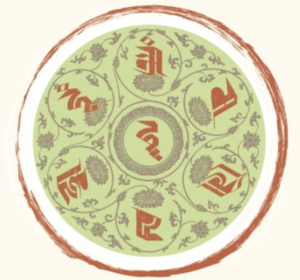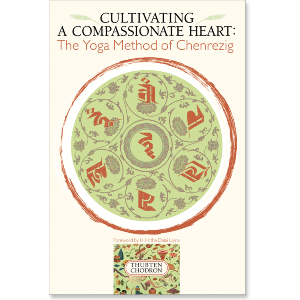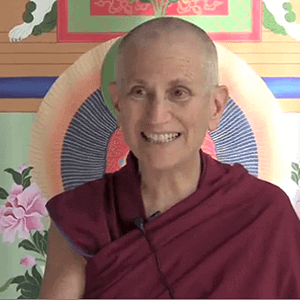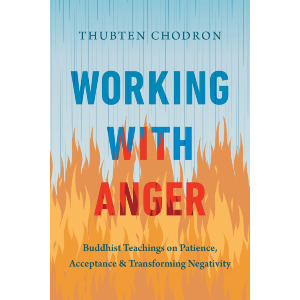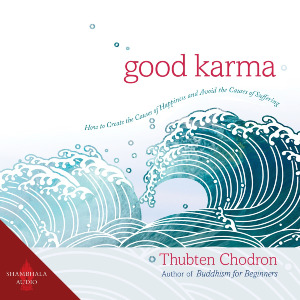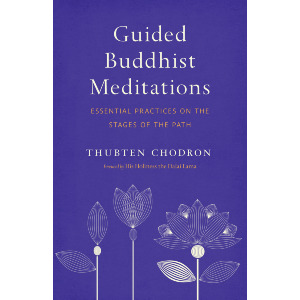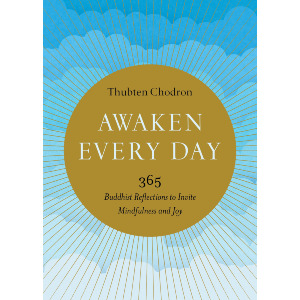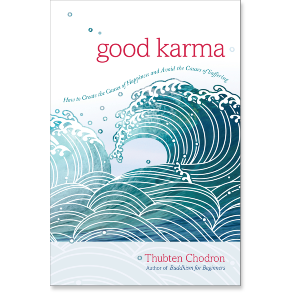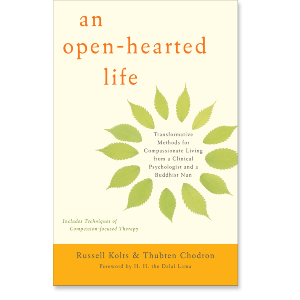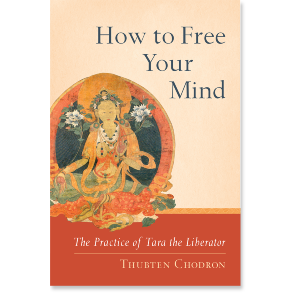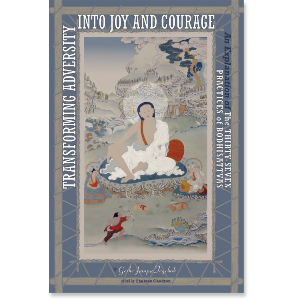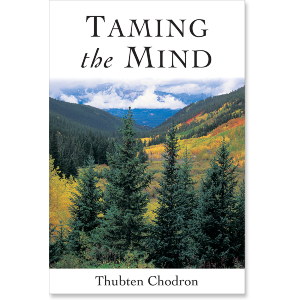The vibration of the mantra affects our body and mind. Reciting mantra has a purifying effect that we can feel physically and mentally. It doesn’t occur immediately, but gradually the energy of the mantra begins to work and calms our mind. However, a stormy period often precedes the pacification of the mind. The pure vibration of the mantra brings out our impure energy, confusion, and other traits that we would rather not look at. We would much rather present ourselves as well-balanced, competent, and confident people, even when we don’t feel that way inside. When our “garbage mind”—as Lama Yeshe used to call it—spills out, we may be alarmed and think that we’re not doing the practice correctly. In fact, we are. Only by exposing the garbage mind can we identify it and free ourselves from it.
Before Mount St. Helens, a volcano in the northwest U.S., exploded in the 1980s, it looked great on the outside—it was lofty, snow covered, and magnificent. Meanwhile, below the surface magma was building up. Similarly, we look great on the outside, but inside there’s volcanic activity, rumbling, and bits of steam sneaking out: “I’m fine. My life’s together. I know what I’m doing. I’ve got to look like a good Dharma practitioner. People shouldn’t see me cry. They shouldn’t know how distracted I am during meditation. I can’t let on how incredibly confused I am.” We think we’re the only one who is confused and not wanting to lose face, we hide our turmoil and pretend to be calmly in charge of the show. But we’re in cyclic existence, so how much control do we really have? How peaceful can we be when we have a samsaric body and mind?
When we meditate and recite mantra, our façade begins to crack, revealing what is really going on in our mind and heart. Attachment, hostility, jealousy, arrogance, vengeance, craving, shame, fear, guilt, and anxiety are starkly apparent. At this time, we shouldn’t wallow in these emotions or become depressed because we have them. Getting discouraged isn’t the purpose of meditation. There’s no reason for the Buddha to have spent forty-five years teaching the Dharma if his goal was for us to be depressed. We can do that all by ourselves.
It’s very good when our garbage mind comes up, because then we have a chance to work with it, clear it out, and apply the antidote to counteract or transform it. Don’t think that you’re doing something wrong when negative emotions surface. Observe them arising, and then apply the thought training teachings to counteract them. The trick is not to get involved in the story behind the emotions. If we do, the emotion will feel very solid. Instead, watch the thoughts that form the story behind the emotion and ask yourself, “Are they true?”
For example, let’s say I’m trying to meditate on Chenrezig and the thought, “My friend betrayed my trust” pops into my mind. If I’m not aware, before long I will be either hurt or angry, depending upon my usual pattern of reacting to such thoughts. I’ll review the details of the story I’ve thought about many times before: “My friends did xyz when I trusted them. Then they did abc.” We might then think, “I was so stupid for trusting them. It’s all my fault,” or “Who do they think they are treating me like that!” or “How could someone do this? What did I do to deserve such treatment?” And away we go. We become screenwriters for the melodrama in our mind. Who is the star of this film? Me, of course.
If we are able to catch this process early on and do not get involved in it, we find it amusing. If we catch it later, after our mind has already bought into the story, we have to apply the antidote. In this case, it’s helpful to contemplate verse 6 of The Eight Verses of Thought Training. We see that we had false expectations that we communicated. Or perhaps they were communicated, but the other person is an imperfect living being, just like us, and thus wasn’t able to fulfill them. We contemplate that our karma got us into that situation: in the past we have betrayed others’ trust and now a similar experience is happening to us. In this way, feelings of hurt and anger fade away.
Another way to counteract negative emotions is to practice divine identity as an antidote. If you start to get self-critical, depressed, or discouraged, remember that you’re Chenrezig. Give yourself another way to look at the situation besides the old pattern, the one that you’ve used before that doesn’t work. Instead, identify yourself as Chenrezig and ask yourself, “How would Chenrezig look at the situation?”
Sometimes we’ll remember a situation that happened ten, twenty, or even thirty or more years ago. If that happens, go into that situation, except this time be Chenrezig. Be there with your family, or whoever it was, and be Chenrezig. As Chenrezig, radiate light from the HRIH at your heart. The light fills the whole room and touches all the people around you. It purifies them, relaxes their minds, and transforms them into Chenrezig. They and we are now Chenrezig, so who will be angry, upset, or disappointed in whom?
Visualizing this is very effective, for it shows us an alternative way to view the situation and to act besides falling into our old, dysfunctional emotional patterns of fear, defensiveness, resentment, inferiority, helplessness, defiance, clinging, or insecurity.
Each time this memory comes to mind, we become Chenrezig and imagine purifying everyone who was in that situation that happened years ago. Each time a habitual emotional pattern arises, we imagine being Chenrezig and imagine reacting the way an enlightened being would react to those circumstances. We do this again and again, each time deepening our understanding of the Dharma and healing the remnants of the past that we carry around with us in our minds. We can meditate like this while chanting the mantra.
A disturbing attitude and emotion will arise in cycles. After we work on it using the Dharma, it probably won’t come up as strongly for a while. It might come up a month later, a year later, or the next time we do retreat, but that time we’ll be able to identify it more quickly and see more clearly how it is based on distorted perception. Some of these issues won’t disappear completely until we attain the path of seeing. We need to be patient and to continue to peel off the layers.
Be enthusiastic about examining the state of your mind and working with it. In some sessions, the mind will be very clear, and you’ll be able to focus on clear appearance and divine identity for a long time. In other sessions, the mind will be restless, and hurt feelings, anger, or jealousy will arise. At other times, the mind will go wild with craving and desire. At these times, it’s helpful to say the mantra, do the various visualizations, and meditate on Lamrim and thought training to help pacify and let go of whatever has come up. Each session will be different as you incorporate into your meditation whatever is going on in your life and mind. When the mind is overwhelmed by afflictions, be creative and find skillful ways to use the Chenrezig meditation to work with them.
Try to recognize when your mind is off track and apply Dharma antidotes right away. This helps enormously. The more we work with these emotions in our meditation, the more we will be able to let go when they arise in our daily life. In similar situations in the future, our attitude will be different because we’ve practiced developing new ones.
Although this meditation stretches our ordinary image of ourselves, we may still keep bumping into it. We sit on our cushion, recite mantra, radiate light to all the sentient beings, and it’s so wonderful. We feel great. It’s so easy to love sentient beings and watch compassionate light flow to them, except for certain sentient beings, such as your boss who criticized you, the neighbor who irritates you, the drunk who swore at you, or the financial consultant who mismanaged your retirement fund. Then we get stuck. We can radiate light to all the sentient beings except to this person. In the middle of our very nice meditation we think of that person and suddenly we stop being Chenrezig. We fall back into our old image of ourselves as little ol’ me who has to defend myself against this person I can’t stand.
When you bump into things like this, try to work with it. Don’t run away, ignore it, or get mad at yourself. Instead, gently investigate, “Why can I radiate light to everybody but this person? What is my button that gets pushed in regards to them?” Notice the question is not, “How can they possibly do that?” or “Why are they so neurotic?” The question is about us: “What are my buttons? Why do I get upset, feel threatened, become insecure? What inside me finds their action or words unbearable?” Exploring this, we learn about ourselves. We apply thought training and Lamrim teachings to work with these emotional hurdles. Slowly, we’ll work our way through them and will be able to extend compassion and radiate light to that person, too.
Self-Righteousness and the Judgmental Mind
Sometimes, just watching the news creates agitation and anger in our mind. Self-righteous feelings and judgment arise because “those idiots” are doing something we don’t like. Work with that self-righteous, judgmental mind in your meditation. Others may do negative actions, but why do we need to be contemptuously “holier than thou” in our response? Why can’t we cultivate a compassionate response to others’ negativity? After all, they’re confused about what causes happiness and what causes suffering, and they’re under the control of mental afflictions which harm them. Thinking in this way enables us to have compassion, because we see that others don’t mean to harm us when they act in certain ways. Then we can send light and purify other sentient beings of their negative karma.
 Someone once asked Lama Yeshe whether Mao Tse-tung was an evil being. His army killed many people and due to his actions, many people, including Lama himself, were adversely affected. Lama looked at us and said, “He meant well, dear.” We were waiting for Lama to make a strong political statement, especially since he had to flee Tibet due to Mao’s army, carrying only his tea cup with him, and enter India as a refugee. We were a group of liberal Westerners, ready to scream “injustice” on behalf of oppressed people, but Lama just said, “He meant well, dear.”
Someone once asked Lama Yeshe whether Mao Tse-tung was an evil being. His army killed many people and due to his actions, many people, including Lama himself, were adversely affected. Lama looked at us and said, “He meant well, dear.” We were waiting for Lama to make a strong political statement, especially since he had to flee Tibet due to Mao’s army, carrying only his tea cup with him, and enter India as a refugee. We were a group of liberal Westerners, ready to scream “injustice” on behalf of oppressed people, but Lama just said, “He meant well, dear.”
Often, people act harmfully but think they’re doing something good. Their minds are overwhelmed by disturbing attitudes and karma. I’m sure we can look at our own past and see things we’ve done and say, “How could I have done that?” Looking back and understanding our own mind, we see that we were overwhelmed by afflictions and karma. We weren’t a horrible person who meant harm. We were just totally confused at that time. Understanding this, we forgive ourselves and, in doing so, become less judgmental and more forgiving of others.
I’m not saying that we should just sit on our cushion and radiate love in response to oppression, poverty, and violence. We need to engage and try to solve the problems in the world, but we should do so with a positive attitude, not with a mind full of despair or anger.
Before or after watching the news, do the Chenrezig meditation and send light out to purify all those sentient beings. Try to figure out which afflictions are motivating them to do what they’re doing, and imagine the light purifying specifically those disturbing attitudes and negative emotions. Think about the kind of karma those people are creating and what kind of results that karma could bring. Ask yourself, “What did they do in the past to make this behavior habitual so that they’re still doing it now?” Then, send light to them to purify the seeds of past actions that cause this habitual behavior and to cleanse the karma they’re creating now so that they don’t have to experience future suffering.
Preferences and Opinions
Our preferences and opinions arise while we meditate and can be great distractions. Often we don’t realize them as the attachments and views that they are. Instead we mentally dig in our heels and insist that our way is right. For example, my teacher, Zopa Rinpoche, likes to begin teaching in the evening and go into the wee hours of the morning. I, however, am a morning person and don’t like staying up late. Sometimes, I become agitated when teachings begin late and have lots of “good” reasons to support why they should begin early: “I practice during the day and am tired. If I go to bed late, I’ll sleep late, and that interferes with my morning meditation. Plus, when teachings begin in the evening, I fall asleep during them, and that’s disrespectful to my spiritual teacher and to the Buddha.” Don’t you think these are good reasons to teach early in the day, not late at night? I think they’re excellent reasons! And probably some other students in the room agree with me. But are these the absolute truths that they appear to be when my mind is agitated? No, they are simply my preferences, and the more I cling onto them the more I suffer.
Having received the novice, or sramanerika, ordination in the Tibetan tradition in 1977, I went to Taiwan in 1986 to receive the full ordination for women and become a bhikshuni. During the one-month training program that surrounded the ordination ceremony, all 500 of us trainees had to file into the main hall and immediately file out of it into the teaching room each morning. To my efficient mind, this was a waste of time; I had a much better plan about how everyone could arrive in the teaching room. Did the ordaining masters care about my plan? Not at all, not to mention the fact that I couldn’t make it known to them because we spoke different languages and that it was out of place for me as a trainee to tell the masters what to do. So for a month I had to bear this inefficiency and waste of time. It was only later that I realized that my agitation was due to attachment to my own preferred way of doing things. It was me who was wasting my time by dwelling on “my way is the right way.”
There are many ways to bring distractions into our meditation so that we work with issues pertinent to our lives. Sometimes we do this by thought training. For example, instead of fighting the situation, we accept that the principal cause is our previous destructive actions. This gives us courage not to follow our self-centeredness and negative emotions in the future. Sometimes we can transform that person into Chenrezig and then see how we feel about him. Try to cultivate pure appearance of him instead of seeing him as ordinary. Instead of labeling “Sam” in dependence on that person’s ordinary aggregates, label “Sam” in dependence on their Buddha-nature. Imagine Sam becomes Chenrezig, and then relate to Sam as if he were Chenrezig.
When you are Chenrezig radiating healing and inspiring light to others, don’t think of sentient beings as an amorphous group. Instead think of specific people. Transform each of them individually into Chenrezig. Try to recognize that they each have Buddha-nature and develop an attitude of equanimity toward them all. Try to see that they’re all empty of inherent existence. Sam has not always been the same Sam with a cut-and-dried fixed personality. In the previous life he wasn’t Sam, and in the future life he won’t be Sam either. One day he will be a Buddha.
Guilt and Shame
When we meditate, things from the past come up, and we have to work with them. We may remember times when we treated others horribly—hurting their feelings, deceiving them, repaying their kindness with spite, manipulating them, cheating them. While regret for these actions is appropriate and necessary to purify these karmas, we often fall into guilt and shame instead. Guilt and shame are obstacles to overcome on the path, because they keep us trapped in our self-centered melodrama entitled “How Bad I Am.” Regret, on the other hand, realizes that we erred, leads us to purify, and motivates us to refrain from acting like that in the future.
How do we counteract guilt and shame? One way is to recognize that the person who did that action no longer exists. You are different now. Is the person who did that action five years ago the same person you are now? If she were exactly the same person, you would still be doing the same action. The present “you” exists in a continuum from that person, but is not exactly the same as her. Look back at the person you were with compassion. You can understand the suffering and confusion she was experiencing that made her act in that way.
A second antidote is to do the taking and giving meditation, thinking, “I will take on the suffering of everybody who did this same horrible action that I did. I will take on the pain of all the victims of these actions.” In this way develop compassion and use it to dissolve the self-centered feeling that says, “I am the worst, the most unforgivable one.”
Another method is to focus on the purification visualization before doing the self-generation as Chenrezig. Imagine that light and nectar stream into you, purifying that negative karma, as well as your guilt and shame. Think that Chenrezig forgives you. A voice inside may say, “Chenrezig, what I did was so terrible, how can you forgive me!” Be careful! That comes close to criticizing a Buddha, doesn’t it? It’s like you’re saying Chenrezig does not know what he is doing when he has compassion for you.
Another way is to meditate on emptiness. The object to be negated is the solid, real “I” who did such a horrible thing five years ago. Search and try to find that “I.” Determine that it either has to be in the body and mind or separate from the body and mind. Start looking: Am I my body? Am I my mind? Search everywhere for this disgusting person you think you are. Finally, the understanding will dawn that you can’t find that person because he or she doesn’t exist. No such inherently existent person is to be found anywhere.
Sometimes you may feel, “I cannot find the solid ‘I,’ but there is still this feeling of ‘I.’ So the feeling must be ‘I.’” Is the feeling or the thought “me” the “I”? Is a thought a person? Is a feeling a person? If I think of a grapefruit, is my thought of a grapefruit a grapefruit? There is a thought or feeling of “I,” but that is not me; that is just a thought, a feeling. When you try to find the one that is me, it’s like trying to catch a rainbow.
Dharma isn’t separate from our daily life. Bring these meditations into your life and use them to solve your problems. Above are some examples of how to do this. Be creative in your own meditations and discover other ways to soothe and dispel your disturbing emotions.


